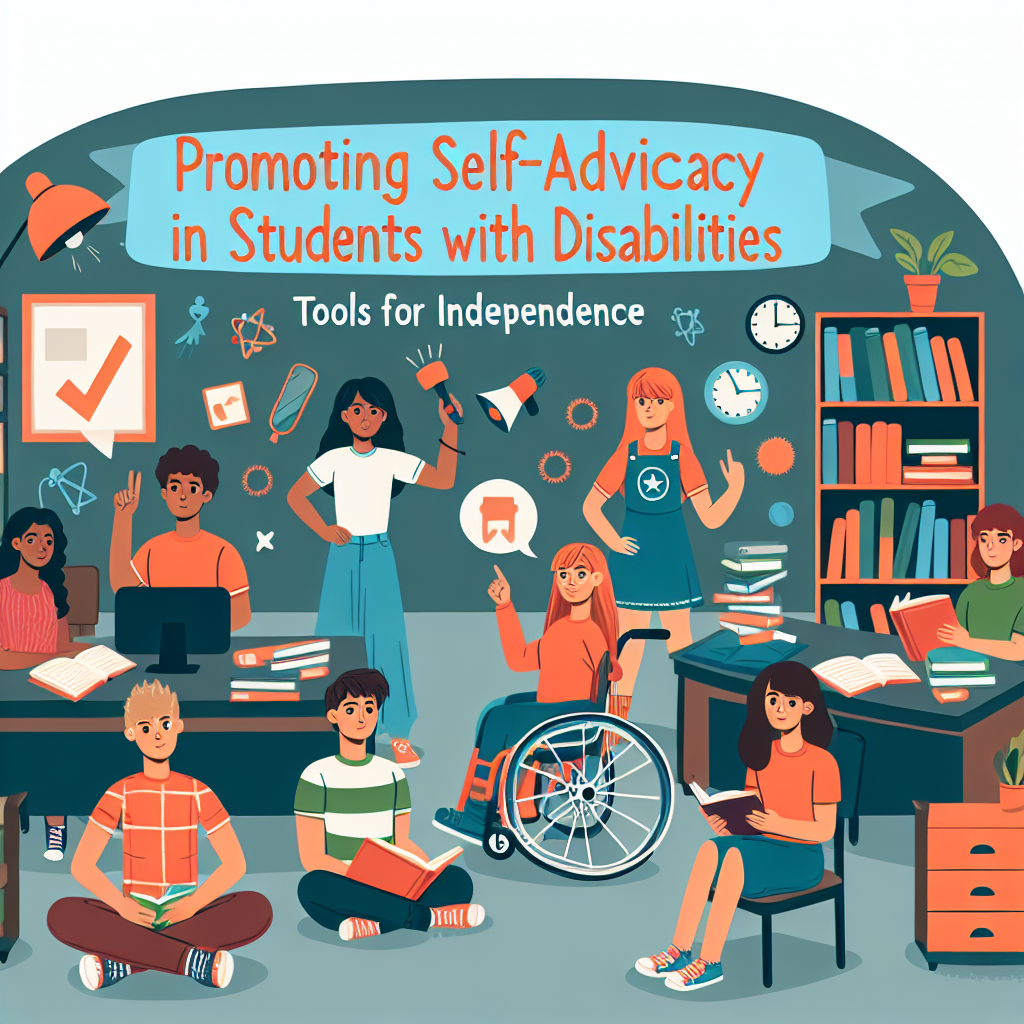
Introduction
Imagine a classroom where every student feels confident enough to voice their needs, wishes, and dreams. This vision becomes a reality when we prioritize Promoting Self-Advocacy in Students with Disabilities: Tools for Independence. Self-advocacy is not just a skill; it’s a vital process that plays a crucial role in the lives of students with disabilities. It empowers them to take charge of their education, assert their rights, and navigate societal challenges with resilience. This article aims to equip educators, parents, and advocates with the tools necessary to foster self-advocacy in students, focusing on actionable strategies, real-world examples, and crucial insights into the journey toward independence.
Understanding Self-Advocacy
What is Self-Advocacy?
Self-advocacy is the ability to express one’s needs and make informed decisions about one’s education and life. In the context of students with disabilities, it encompasses understanding their rights, knowing how to communicate their needs, and actively participating in decisions that affect their learning experience.
Importance of Self-Advocacy
Promoting self-advocacy in students with disabilities is essential for several reasons:
- Empowerment: It instills a sense of control and autonomy.
- Confidence: Students learn to embrace their uniqueness and articulate their strengths.
- Resilience: Developing self-advocacy skills equips students to face challenges head-on.
- Success Beyond School: These skills translate into adult life, where personal advocacy is key in managing jobs, relationships, and more.
Real-World Impact
The National Center for Learning Disabilities (NCLD) emphasizes that self-advocacy is linked to improved educational outcomes and better life satisfaction. For instance, students who successfully advocate for themselves typically score higher academically and report better mental health.
Strategies for Promoting Self-Advocacy
Create a Supportive Environment
Foster Open Communication
Creating an environment where students feel safe expressing their thoughts and feelings is a foundational step in Promoting Self-Advocacy in Students with Disabilities: Tools for Independence.
- Classroom Activities: Hold regular discussions and feedback sessions.
- Listening Sessions: Encourage students to share their experiences and perspectives without judgment.
Teach Self-Knowledge
Knowledge is the cornerstone of self-advocacy. Helping students understand their disabilities and how they affect their learning can promote independence.
Self-Assessment Tools
Integrate self-assessment tools that encourage students to reflect on their strengths, weaknesses, and preferred learning styles. Resources like the Learning Styles Inventory can guide this process.
| Description | Tool | Purpose |
|---|---|---|
| Learning Styles | VARK | Helps identify a student’s preferred way of learning |
| Strengths Finder | Clifton | Enables students to explore their personal strengths |
Goal Setting
Encourage students to set personal and academic goals. SMART goals (Specific, Measurable, Achievable, Relevant, Time-bound) provide a structured framework for accountability and motivation.
Case Study: Empowering Alex
Background: Alex, a high school junior with ADHD, had difficulty advocating for his accommodations. After a series of coaching sessions focusing on self-knowledge and goal-setting, Alex learned about his learning style and how it influenced his academic performance.
Outcome: Alex successfully communicated with his teachers about his need for extended test times. Consequently, his grades began to improve, and he rapidly gained confidence in articulating his needs in various settings.
Analysis: This case illustrates the power of self-knowledge and structured guidance. By enabling Alex to understand his disability and articulate his needs, he transformed his educational experience.
Tools and Resources that Facilitate Self-Advocacy
Assistive Technology
Technology can play a pivotal role in empowering students with disabilities. Tools such as speech-to-text software, organizational apps, and digital note-taking platforms can assist in various educational tasks.
| Tool | Purpose |
|---|---|
| Dragon NaturallySpeaking | Converts speech to text |
| Notability | Digital note-taking |
| Trello | Task and project management |
IEP and 504 Plans
Drafting Individualized Education Plans (IEPs) or 504 Plans that focus on self-advocacy is crucial. These plans should include:
- Goals for Advocacy: Specific, measurable objectives focusing on advocacy skills.
- Student Involvement: Strategies to involve students in IEP meetings to foster ownership and self-advocacy.
Peer Mentorship Programs
Peer mentorship can create a support system and instill confidence in students with disabilities. Pairing students with mentors who have successfully navigated their own advocacy journeys can be motivating and instructive.
Case Study: Building a Mentorship Program
Background: A local high school launched a peer mentorship program where seniors mentor freshmen with disabilities. The program initiated a workshop focused on self-advocacy skills.
Outcome: Students reported feeling more empowered to express their needs. Additionally, mentors found personal growth and fulfillment through the experience.
Analysis: This case underlines the multifaceted benefits of peer mentorship in Promoting Self-Advocacy in Students with Disabilities: Tools for Independence.
Educator Training and Support
Professional Development
Educators must be equipped with the skills and knowledge to foster self-advocacy in their classrooms. Regular professional development sessions focusing on special education laws, advocacy strategies, and differentiated instruction can enhance teacher effectiveness.
Collaborative Teaching Models
Implementing co-teaching models that involve special education and general education teachers can provide an inclusive learning environment. Collaborating on lesson plans and recognizing individual needs can build a more supportive atmosphere for students with disabilities.
Case Study: Co-Teaching Success
Background: A middle school instituted a co-teaching model where special education and general educators worked together.
Outcome: Students reported feeling more included, and the co-teachers effectively advocated for their students’ needs, making accommodations more responsive.
Analysis: This highlights the significance of collaboration in fostering an environment conducive to self-advocacy, demonstrating that teacher training is pivotal for success.
Overcoming Challenges in Self-Advocacy
Addressing Stigma
One of the biggest challenges is the stigma associated with disabilities. Helping students navigate societal perceptions is crucial in Promoting Self-Advocacy in Students with Disabilities: Tools for Independence.
- Awareness Campaigns: Schools can launch initiatives to educate peers on disabilities and promote a culture of understanding.
Building Confidence Amid Loss of Trust
Some students may have previously faced obstacles in being heard. Rebuilding trust is imperative.
- Small Wins: Start with manageable tasks, such as encouraging students to speak up in smaller group settings, leading to larger opportunities for advocacy.
Case Study: Building Trust
Background: In a community focused on disability advocacy, teachers implemented small group discussions to facilitate student voice.
Outcome: Gradually, students who once felt muted began to advocate for accommodations and expression within larger forums.
Analysis: This case illustrates the importance of starting small and building towards larger advocacy, evidencing the gradual rebuilding of trust and confidence.
Conclusion
Promoting self-advocacy in students with disabilities is not an isolated endeavor; it acts as a catalyst for independence and success. As educators, parents, and advocates, we have the profound responsibility to equip students with the tools they need to navigate their lives confidently. By fostering self-awareness, offering resources, and creating supportive environments, we can help students assert themselves, articulate their needs, and pave the road to a future defined by independence and fulfillment.
Together, let’s champion the cause of self-advocacy, creating pathways that enable each student to thrive, empowering them to advocate for themselves today and in their future endeavors.
FAQs
1. What are the best practices for promoting self-advocacy in students with disabilities?
Best practices include creating open communication environments, providing self-knowledge resources, and facilitating goal-setting exercises.
2. How can assistive technology help in self-advocacy?
Assistive technology provides tools that support learning and communication, enabling students to express their needs more effectively.
3. Why is it essential for students to participate in their IEP meetings?
Participation fosters ownership, allowing students to learn about their rights and preferences while voicing their needs directly.
4. How can parents encourage self-advocacy at home?
Parents can model self-advocacy, encourage open discussions about needs, and help navigate resources that support independence.
5. What role do peer mentorship programs play?
Peer mentorship programs provide networks of support, making navigation through advocacy easier and providing role models for students with disabilities.
By addressing these important questions and diving deeper into strategies for promoting self-advocacy, we can create a culture that values independence and empowers every student.














